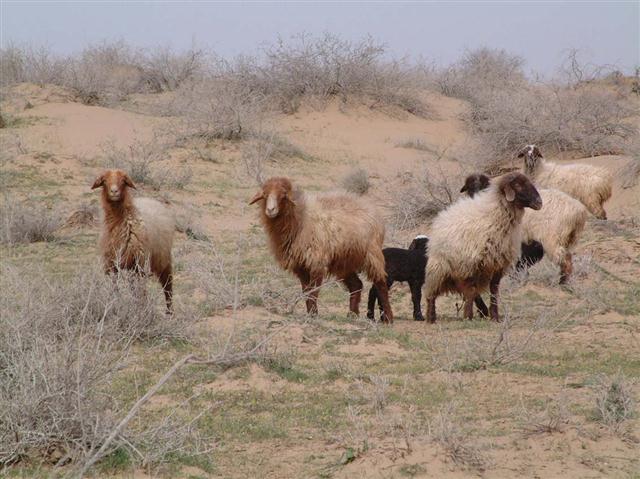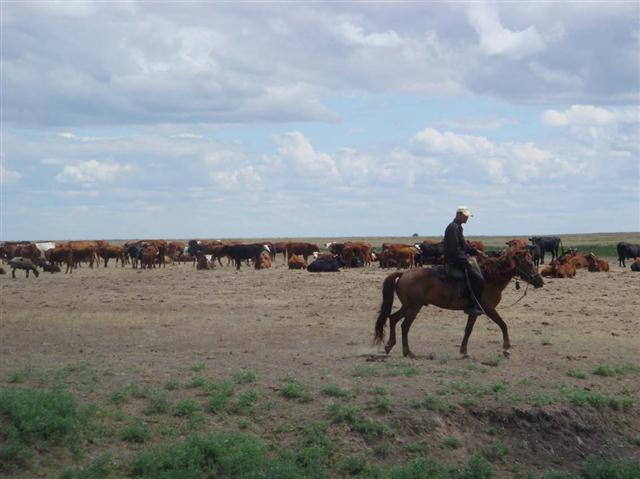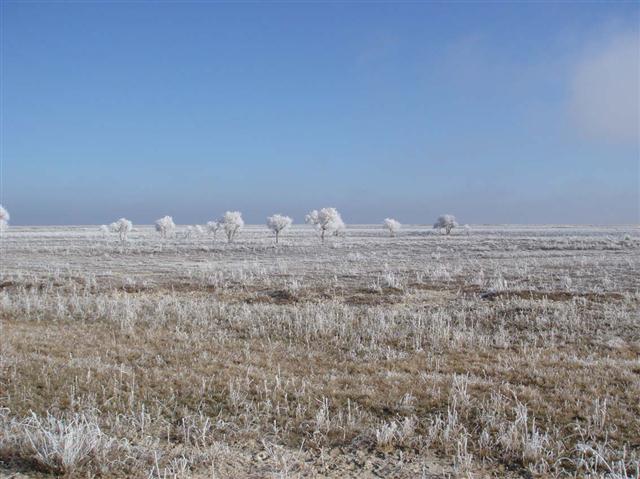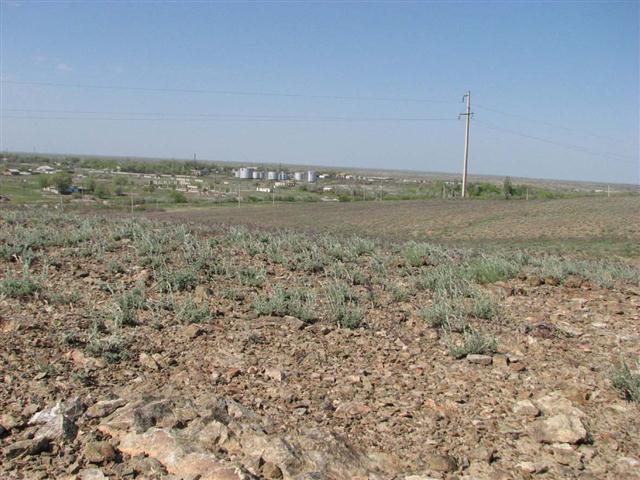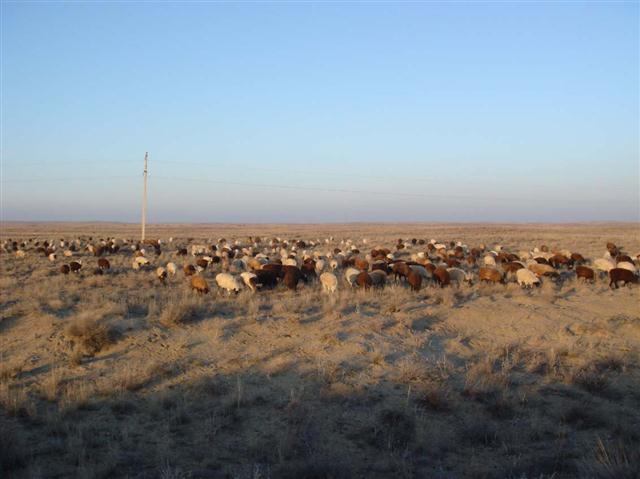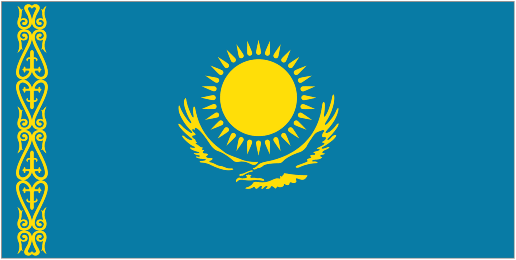CBA Kazakhstan: Adapting Grazing Stock-Raising in Lepsy Village (Farmer Foundation)
Project Overview
Lepsy village is a pastoral community of approximately 3,100 people, living in Sarkand District, Almaty Oblast, Kazakhstan. As temperatures increase in the winter and levels of evapotranspiration increase in the summer, the region has observed small declines in overall annual rainfall, but significant decreases in winter precipitation. As winter temperature increases, less soil moisture is available for fodder growth during the spring, lowering grazing capacity for local livestock and contributing to pasture degradation.
This Community-Based Adaptation project builds on baseline sustainable rangeland management measures to facilitate extension of community pastures through the expansion of traditional waterpoints and identification/implementation of sustainable pasture management strategies that take changing climatic and ecological parameters into account. The project also focuses on capacity-building activities, as well as disseminating best practices at a national level.
* This project is part of Kazakhstan's Community-Based Adaptation portfolio. *
Project Details
The pastoral community of Lepsy, in the northern desert of Kazakhstan, is home to about 3,100 people. The climate in Lepsy is extremely dry, with long, cold winters and hot summers. Winter snow is the only agriculturally useful precipitation: melting snow seeps into the soil and contributes to soil moisture and groundwater, but summer precipitation evaporates too quickly to be absorbed by plants.
This fragile ecosystem, consisting of sandy hills covered with wheat grass and cypress vegetation, is threatened by increasing aridity. The environment also suffers from poor pasture management. Disruptions to traditional seasonal grazing and pasture rotation practices have resulted in overgrazing. The community’s livelihood depends largely on products generated by livestock. In order to raise high quality cattle, local residents must have access to fertile pasturelands. Increased aridity brought on by climate change puts both the ecosystem and inhabitants’ livelihoods at risk by reducing the amount of forage available for grazing. Having observed the negative impact of climate change upon livestock productivity, the community has decided to implement adaptation measures to ensure that climate change doesn’t further threaten their livelihoods.
This Community-Based Adaptation project aims to reduce the community’s vulnerability to climate change and conserve the sand pasture ecosystem. The project was prepared through a participatory process carried out by the local NGO, Farmers Foundation of Kazakhstan, and is working to protect the viability of residents’ pastoral livelihoods. The community is benefitting from the implementation of pasture management practices that maximize scarce water resources. Sustainable strategies to reduce the grazing load and enable cattle distribution include the transfer of some cattle to unused remote rangelands, setting up a system of seasonal pasture rotations, and optimizing water supply by rehabilitating traditional wells.
The project also contains an important capacity-building component that trains community members in water and pastoral resource management. Additionally, practices that best reduce climate change impacts on sandy rangelands will be disseminated for use in similar ecosystems in Kazakhstan, which total more than 31 million hectares.
Key Results and Outputs
Outcome 1 (co-financing): Traditional seasonal use of medium- and long-distance pastures restored
Repair 7 waterpoints in the medium distance pastures, using the traditional Kazakh technique “Asar” (Output 1.1). Optimally load new pastures through development of community-based agreements (Output 1.2). Observe seasonal pasture rotations (Output 1.3) and implement remote-grazing practices to reduce near-village overgrazing (Output 1.4).
Outcome 2 (co-financing): Community capacity built to cooperatively manage shared pasture resources
Create local-level institutions to facilitate resource-use cooperation (Output 2.1) and improve community access to watering sites and forage resources (Output 2.2).
Outcome 3 (CBA-funded): Community’s capacities strengthened to address projected climate change risks
Enable community-based institutional mechanisms (on resource use and cooperation) to take climate change into account (through education and training) (Output 3.1). Improve community awareness of climate change risks, and capacity to implement climate resilient livestock production practices (Output 3.2).
Outcome 4 (CBA-funded): Climate change pressures on decreasingly resilient waterpoints reduced
Take climate change into account for grazing loads around waterpoints (Output 4.1) and redistribute grazing loads accordingly by identifying new waterpoints (Output 4.2). Enable community members to practice traditional and alternative methods of water collection and conservation within the pastures (earth reservoirs, water collection pits, etc.) (Output 4.3). Expand watered pasture areas (Output 4.4).
Outcome 5 (CBA-funded): Pasture management practices take climate change risks into account
Taking climate change into account, set standards in place (Output 5.1) and enable community members to practice optimal pasture loading (Output 5.2).
Outcome 6 (CBA-funded): Lessons learned from project implementation inform government policy and global learning
Develop lessons learned and best practice documents (Output 6.1) and incorporate them into local area development plans (Output 6.2). Disseminate new pasture management strategy on the national and local levels (Output 6.3).
Reports and Publications
Annual Reports
PIFs
Assessments and Background Documents
Project Brief / Fact Sheet
Monitoring and Evaluation
Monitoring and evaluation for community-based adaptation is a new field, and the CBA project is piloting innovative approaches to evaluating the success of locally-driven adaptation projects, and generating lessons to inform ongoing practice.
Key considerations in M&E for CBA include:
- Grounding M&E in the local context: M&E for CBA should avoid overly rigid frameworks, recognizing community heterogeneity and maintaining local relevance
- Capturing global lessons from local projects: CBA projects are highly contextualized, but lessons generated should be relevant to stakeholders globally
- Incorporation of both quantitative and qualitative indicators: to ground projects in tangible changes that can be objectively evaluated, and to capture lessons and case studies for global dissemination
To these ends, the CBA project uses three indicator systems: the Vulnerability Reduction Assessment, the Small Grants Programme Impact Assessment System, and the UNDP Climate Change Adaptation Indicator Framework.
The Vulnerability Reduction Assessment (VRA)
The VRA is a question-based approach with the following aims:
- To make M&E responsive to community priorities
- To use M&E to make projects more accountable to local priorities
- To make M&E capture community ideas and local knowledge
- To gather community-level feedback to guide ongoing project management
- To generate qualitative information
- To capture lessons on specific issues within community-based adaptation
- To generate case studies highlighting adaptation projects
The VRA follows UNDP's Adaptation Policy Framework, and is measured in a series of meetings with local community stakeholders. In these meetings, locally-tailored questions based on standard VRA questions/indicators are posed, and the community assigns a numerical score on a 1-10 scale for each question. Progress is evaluated through changes in scores over the course of implementation, as well as through qualitative data collected in community discussions surrounding the exercise.
UNDP has developed a Users Guide to the VRA (Espanol) (Francais) as a tool to assist practitioners to conceptualize and execute VRA measurements in the context of CBA projects.
The SGP Impact Assessment System (IAS)
The CBA, being a project of the GEF Strategic Priority on Adaptation, aims to increase the resilience of ecosystems and communities to the impacts of climate change, generating global environmental benefits, and increasing their resilience in the face of climate change impacts. To this end, the CBA projects use the SGP's impact assessment system for monitoring achievements in GEF focal areas (focusing primarily on biodiversity and sustainable land management).
The IAS is composed of a number of quantitative indicators which track biophysical ecosystem indicators, as well as policy impact, capacity development and awareness-building.
UNDP Climate Change Adaptation Indicator Framework
CBA projects also track quantitative indicators from UNDP's adaptation indicator framework, corresponding to the thematic area on natural resources management. More information on UNDP's indicator framework can be found on the UNDP climate change adaptation monitoring and evaluation website.
* This description applies to all projects implemented through UNDP's Community-Based Adaptation programme. Specific details on this project's M&E will be included here as they become available. *
